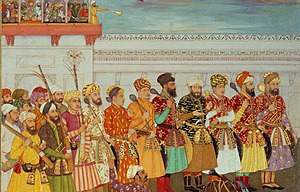The period from 1600 to 1650 was marked by significant developments in the region that would later become Pakistan. During these five decades, the subcontinent experienced the continuation of the Mughal Empire’s rule, social and cultural transformations, economic prosperity, and the emergence of new power centers. Let’s explore the political, social, economic, and other key events that shaped this era.
1. The Mughal Empire in the Early 17th Century:
Political Landscape: The Mughal Empire continued to dominate the Indian subcontinent during the early 17th century. Emperor Jahangir (1605-1627) ruled over a vast and prosperous empire. His reign was characterized by stability, but he faced challenges from within the court, including the powerful influence of his wife Nur Jahan.
Social and Cultural Developments: The Mughal court during Jahangir’s rule was known for its patronage of the arts and culture. The era witnessed the flourishing of Mughal painting, with artists like Mansur and Bichitr gaining prominence. Persian culture and literature continued to influence the elite, and the Mughal court became a center of artistic and intellectual activity.
Economic Prosperity: The Mughal Empire remained one of the world’s wealthiest empires during this period, thanks to its control over lucrative trade routes and the flourishing agrarian economy. Trade with Europe, Persia, and Southeast Asia brought significant revenue to the empire.
2. The Arrival of the British East India Company:
Emergence of British Influence: In the early 17th century, the British East India Company began to establish its presence in the Indian subcontinent. Initially, the British were focused on trade, setting up trading posts and factories along the coasts. Their arrival marked the beginning of British influence in the region.
3. The Mughal Decline and the Rise of Regional Powers:
Political Challenges: In the latter part of the 17th century, the Mughal Empire began to face political challenges. Emperor Shah Jahan (1628-1658) faced a rebellion by his son Aurangzeb, leading to a war of succession. The prolonged conflict weakened the empire’s central authority.
Emergence of Regional Dynasties: As the Mughal Empire weakened, various regional dynasties emerged in different parts of the subcontinent. In Sindh, the Kalhora dynasty established its rule, while the Deccan saw the rise of the Qutb Shahi dynasty and the Adil Shahi dynasty. These regional powers asserted their autonomy and control over their respective territories.
4. Socio-Cultural Dynamics:
Continued Growth of Sufism: Sufism continued to play a prominent role in the spiritual and cultural life of the subcontinent during this period. Sufi saints and their followers spread Islam and promoted religious tolerance. Sufi shrines and khanqahs (spiritual centers) became important hubs of spiritual and social activity.
Literature and Poetry: The 17th century witnessed the flourishing of Urdu and Persian literature. Renowned poets like Mir Taqi Mir and Mirza Ghalib left a lasting impact on poetry and literature in the subcontinent.
5. Economic Developments:
Trade and Commerce: Despite political challenges, trade and commerce remained vibrant. Major cities like Lahore and Multan continued to be important trade centers, facilitating commerce between the subcontinent and regions like Central Asia and Persia.
Agriculture and Agrarian Economy: Agriculture remained the backbone of the economy. The fertile lands of the Indus Valley and the Punjab region continued to yield substantial agricultural produce, ensuring a steady flow of revenue for the ruling powers.
6. Conflicts and Wars:
Mughal-Maratha Conflict: One of the significant conflicts during this period was the Mughal-Maratha war, which lasted for several decades. The Marathas, a regional power in the Deccan, challenged Mughal authority in central India. This prolonged conflict further weakened the Mughal Empire.
7. Cultural Exchange:
Impact of European Traders: European traders, including the Portuguese and later the Dutch and the English, continued to expand their influence in the region. Their presence led to cultural exchanges, as they introduced new foods, textiles, and technologies to the subcontinent.
Conclusion:
The period from 1600 to 1650 was marked by the continuation of the Mughal Empire’s rule, the emergence of regional powers, cultural and artistic flourishing, and the beginning of British influence in the Indian subcontinent. While the Mughal Empire remained a dominant force, signs of its decline were becoming increasingly evident. Regional dynasties and powers began to assert their autonomy, setting the stage for significant political changes in the centuries to come.
This era laid the foundation for the complex socio-political landscape of the subcontinent, with cultural legacies, artistic achievements, and economic prosperity continuing to shape the region’s identity. The subsequent decades would witness further transformations and the eventual transition to colonial rule under the British Empire.

